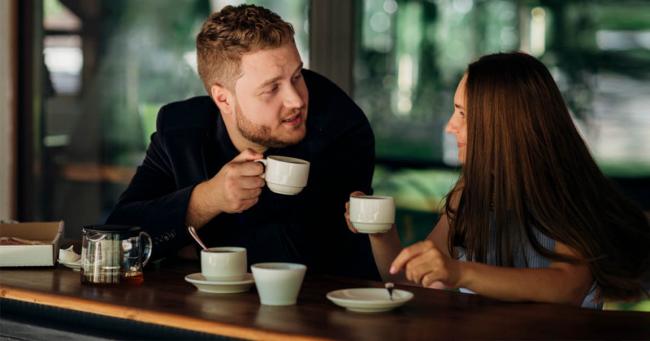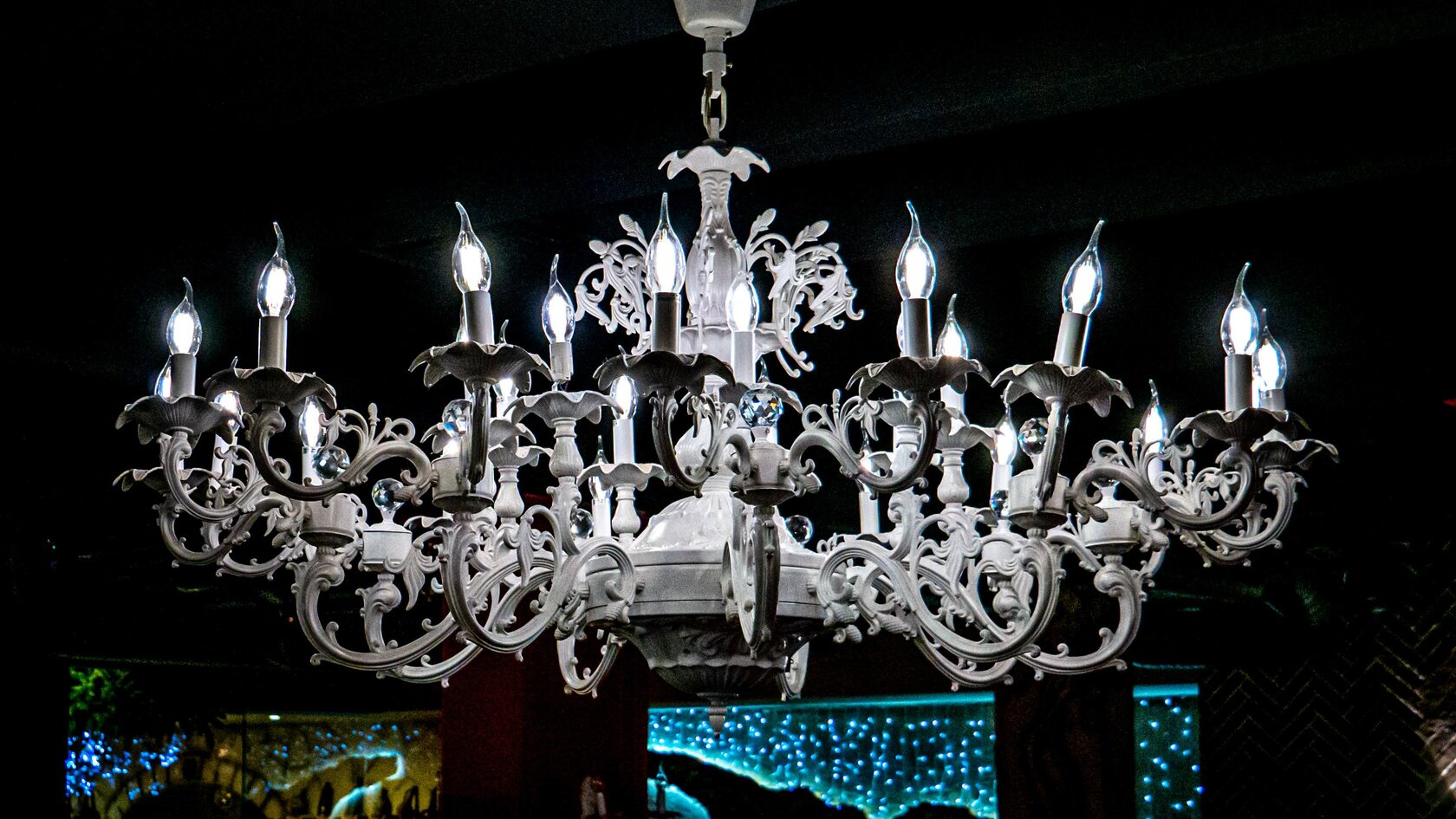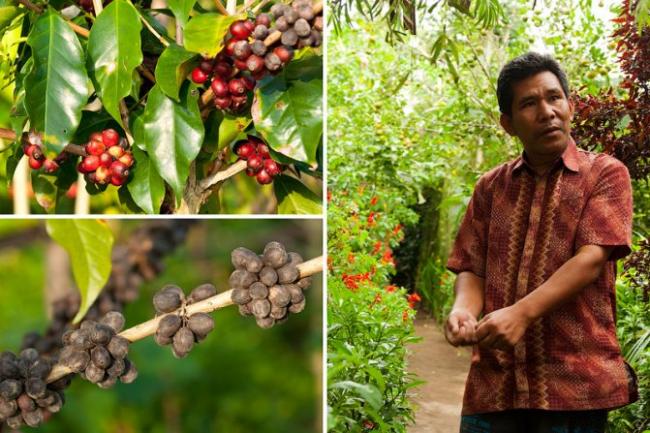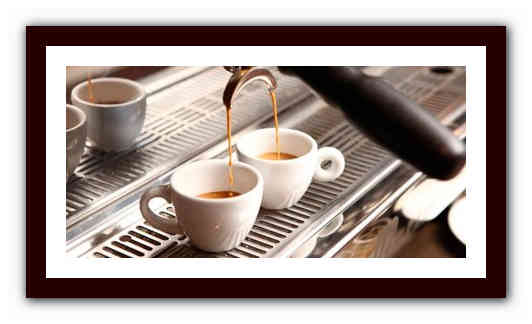Что такое кофе доппио
Это двойная порция крепкого эспрессо,который варят по классическому рецепту. Этот напиток получил такое название из-за своего объема,который увеличен в два раза. Двойной эспрессо имеет очень крепкий и достаточно насыщенный аромат и вкус. Если вы предпочитаете такие напитки, тогда этот, придет вам точно по душе.
Эфиопию считают родиной кофейных напитков. Согласно легенде, один пастух, который проходил очередной холм, заметил много овец, которые питались черными неизвестными зернами. Животные были чересчур активны, поэтому пастух заинтересовался этим продуктом и захотел испытать это на себе.
Он взял эти плоды и кинул в огонь. И сразу же повеял невероятный запах. И именно с того момента весь мир узнал о существовании кофе.
Кофе доппио лучше всего пить для того, чтобы активизировать внутренние органы. Двойной эспрессо подарит вам прекрасный заряд энергии на полный день. Также он будет прекрасным элементом в разговоре с друзьями и родственниками.
Чтобы получить еще больше удовольствия, этот напиток рекомендуется пить небольшими глотками. Так вы точно прочувствуете вкус эспрессо.
Как приготовить doppio?
Теперь расскажем вам о том, как правильно готовить двойной эспрессо. Как уже было замечено выше, сварить хороший эспрессо доппио можно только при наличии кофемашины. Можно использовать также гейзерную кофеварку, но лучше придерживаться оригинального способа, чтобы получить именно тот вкус, за который так ценится этот напиток.
Ингредиенты
Для приготовления двойного эспрессо вам понадобятся следующие ингредиенты:
- Холодная вода — 120 миллилитров.
- Молотый кофе — 15-17 грамм.
- Сахар — по вкусу.
- Корица, шоколадная крошка, миндальная стружка и другие топпинги — по желанию.
Процесс приготовления
Чтобы приготовить такой кофе по оригинальному рецепту:
- Включите и прогрейте кофемашину.
- Прогрейте посуду для кофе.
- Молотый кофе поместите в холдер кофемашины и спрессуйте темпером.
- Залейте в устройство очищенную холодную воду.
- Включите на 3 секунды пролив воды, чтобы зерна пропитались.
- После этого запустите варку.
- Через 40 секунд остановите процесс.
- Разлейте готовый кофе в прогретую посуду, украсьте топпингами и подавайте к столу.
FAQs
How much doppio should you drink?
You should drink a maximum of 2-3 doppios per day. The recommended daily caffeine intake for an adult is 400 mg, and a 60 ml doppio can contain between 140-160 mg of caffeine. If you want to get the doppio experience without the total amount of caffeine, you can switch to decaf. A 60 ml doppio made with decaffeinated beans contains 10-30 mg of caffeine.
How to make doppio at home without a machine?
It’s not possible to make a doppio at home without a machine. Doppio is an espresso, and you can only make authentic espresso using the 9 bars of pressure created by an espresso machine. You can make espresso-style coffee at home with a Nespresso machine, Moka pot, or French press, in which case a doppio would be a larger serving.
What does doppio taste like?
A doppio tastes precisely like an espresso, with a concentrated coffee taste and aroma. A well-extracted doppio will have a palate balanced between sweet, acidic, and bitter. The individual flavour notes will depend on the espresso beans used and can be anything from sweet and fruity to earthy and nutty.
Chapters / Episodes
Manga Appearances
Chapters in order of appearance
- Chapter 541: Storm Warning in Sardinia Island!
- Chapter 542: My Name Is Doppio, Part 1
- Chapter 543: My Name Is Doppio, Part 2
- Chapter 544: King Crimson vs. Metallica, Part 1
- Chapter 545: King Crimson vs. Metallica, Part 2
- Chapter 546: King Crimson vs. Metallica, Part 3
- Chapter 547: King Crimson vs. Metallica, Part 4
- Chapter 551: Pronto! On the Phone, Part 1
- Chapter 552: Pronto! On the Phone, Part 2
- Chapter 553: Destination: Rome! The Colosseum
- Chapter 567: “Green Day” and “Oasis”, Part 14
- Chapter 568: His Name Is Diavolo, Part 1
- Chapter 569: A Little Story from the Past
- Chapter 570: His Name Is Diavolo, Part 2
- Chapter 574: The Requiem Quietly Plays, Part 3 (Mentioned only)
- Chapter 576: The Requiem Quietly Plays, Part 5 (In Bruno Bucciarati’s body)
- Chapter 577: The Requiem Quietly Plays, Part 6 (In Bruno Bucciarati’s body) (Death)
Anime Appearances
Episodes in order of appearance
- Golden Wind Episode 21: The Mystery of King Crimson (Voice only)
- Golden Wind Episode 26: A Little Story from the Past ~My Name Is Doppio~ (1st full appearance)
- Golden Wind Episode 27: King Crimson vs. Metallica
- Golden Wind Episode 28.5: destino
- Golden Wind Episode 29: Destination: Rome! The Colosseum
- Golden Wind Episode 32: Green Day and Oasis, Part 3
- Golden Wind Episode 33: His Name Is Diavolo
- Golden Wind Episode 34: The Requiem Quietly Plays, Part 1
- Golden Wind Episode 35: The Requiem Quietly Plays, Part 2
- Golden Wind Episode 36: Diavolo Surfaces (Death)
Отличия doppio от других кофейных напитков
Why Is It Called A Doppio?

References to classic Italian espresso culture in the United States are sometimes comical and sometimes confusing.
Many words you’ll see on today’s coffee shop menus came to us via Starbucks. For example, the ubiquitous use of the term “macchiato” to describe a giant caramel milkshake. Other traditional Italian words have also been warped by the marketing engine of the American coffee industry.
One term that Starbucks popularized in Seattle in the 1980s and 1990s is “doppio.”
In Seattle, under the watchful eye of a certain green mermaid, the use of the word doppio is still going strong today. In fact, if you order a “double” in Seattle, many baristas will check in with you to make sure you didn’t mean “two doppios.”
In other parts of the country, though, saying doppio in a high-end coffee shop might make you stand out as someone who’s not an industry-insider.
When a genuine professional barista hears you use the word doppio anywhere outside of a Starbucks, they may think one of the following things:
- You’re from Seattle.
- You just arrived from Italy and came to their shop because you’re looking for some serious coffee.
- You traveled here in a time machine from 1992 and are still adjusting to modern culture.
- Your knowledge of industry trends hasn’t caught up with your genuine love of coffee, and you are an excellent candidate for becoming a loyal regular.
So, if you ask for a doppio in a fancy café and the barista starts asking you lots of prying questions about your order, don’t be afraid. They’re just trying to figure out what kind of customer you are and how best to serve you. If you want to touch up on various types of coffee pay a visit to our comprehensive database.
Origin
Let’s step back into European history to get a better idea of why the Doppio is still one of the most beloved espresso-based drinks that gives a nice little kick. The name itself is derived from Latin and is a combined version of three combined Latin words. This includes Dous, Plus, and Pleo which create the word “Duplus”. When this was translated into Italian, the rough word that came from this became Doppio. Pronounced “DOH-pee-oh,” the word just means “double” in Italian.
Since the Italians were masters at the culinary craft of roasting and combining espresso beans, they would call each shot that was extracted from their crude espresso machines either a solo or Un Café which is also a single shot of espresso. Since a solo and doppio were synonymous with a single or double shot of espresso, they really didn’t need much attention when being served as a specific drink concoction.
Those who order a single or double-shot would then add sugar or cream to their espresso and enjoy it as soon as it was served. Unlike other drink recipes, a doppio is very simple to make since it’s just a double shot of espresso that is twice the amount of espresso that you would normally get at the café where it was ordered.
How do you prepare a doppio?
- Espresso machine
- Double portafilter basket
- 20g coffee beans
- Coffee grinder
AT A GLANCE:
BREW TIME:
3 minutes
YIELD
1 cup
How to make a doppio:
- Grind your beans to a medium-fine grind, exactly as you would for espresso.
- Fill and tamp a double portafilter and place it into the espresso maker.
- Place the scale under your cup and start the extraction.
- Stop the extraction when you reach a volume of 60 ml, which should take around 25-30 seconds.
What are the differences between doppio and Americano?
The main difference between the doppio and Americano is the addition of hot water. An Americano is made by pulling a shot of espresso into a 175-236 ml glass and topping it with hot water. As a result, it has a much less concentrated coffee taste than a doppio. An Americano made using a single shot of espresso contains 70-80 mg of caffeine, compared to 140-160 mg for a doppio espresso.
If you’re looking for another version of a less concentrated espresso, you may want to read up on the lungo.
What is the difference between doppio and espresso?
The only difference between doppio and espresso is the serving size. Traditionally an espresso is 30 m, and a doppio is 60 ml. A doppio and espresso are made with the same ratio of coffee to water and have the same taste, aroma, and concentration of caffeine. The only difference is in the levels of caffeine. Due to the larger serving size, a doppio espresso contains 140-160mg of caffeine, which is more than 70-80 mg for a single espresso.
What are the differences between doppio and ristretto?
The critical difference between doppio and ristretto is the ratio of coffee to water. A ristretto is a more concentrated coffee made by extracting coffee and water at a 1:1 ratio. A doppio uses the same ratio as a regular espresso, at 1:1.5-1:2. A ristretto means a shorter extraction time, which can highlight different flavours in the beans, making them richer and sweeter.
FAQs
How much doppio should you drink?
You should drink a maximum of 2-3 doppios per day. The recommended daily caffeine intake for an adult is 400 mg, and a 60 ml doppio can contain between 140-160 mg of caffeine. If you want to get the doppio experience without the total amount of caffeine, you can switch to decaf. A 60 ml doppio made with decaffeinated beans contains 10-30 mg of caffeine.
How to make doppio at home without a machine?
It’s not possible to make a doppio at home without a machine. Doppio is an espresso, and you can only make authentic espresso using the 9 bars of pressure created by an espresso machine. You can make espresso-style coffee at home with a Nespresso machine, Moka pot, or French press, in which case a doppio would be a larger serving.
What does doppio taste like?
A doppio tastes precisely like an espresso, with a concentrated coffee taste and aroma. A well-extracted doppio will have a palate balanced between sweet, acidic, and bitter. The individual flavour notes will depend on the espresso beans used and can be anything from sweet and fruity to earthy and nutty.
Как подавать и пить кофе доппио
Мало приготовить кофейный напиток по рецепту. Чтобы полностью насладиться вкусом арабики, кофе следует правильно подавать. Желательно использовать для церемонии керамические или фарфоровые чашечки с толстыми стенками.
Оптимальное время для такого напитка – первая половина дня. Двойной эспрессо (доппио) подается сразу после приготовления. Наслаждаться им нужно до остывания. Чтобы лучше ощутить вкус напитка, добавлять в него сахарный песок не рекомендуется.
Для многих вкус может показаться горьковатым, поэтому можно «подсластить» его сливочным десертом. Альтернативный вариант – подача кофе вместе с орехами или печеньем. Некоторые гурманы предпочитают пить доппио вместе с сыром и горьким шоколадом.
Сервировать стол нужно посудой из одного сервиза.
Лучше всего использовать чашки демитассе. Объем должен быть не менее 120 мл (см. объем кофейной чашки). В идеале, их необходимо прогреть перед тем, как наливать кофе. Это можно сделать с помощью кофемашины, либо в обычной микроволновке.
Прежде чем пить кофе, нужно сделать глоток воды, чтобы очистить рецепторы. По глотку воды можно делать после каждого глотка кофе, но последний глоток доппио запивать водой нельзя: это оскорбление для бариста.
Последний глоток кофе запивают водой только в том случае, если вкус напитка не понравился и хочется поскорее от него избавиться. Доппио закусывают шоколадом, фруктами, твёрдым сыром.

Не стоит отказывать себе в удовольствии ощутить приятный горьковатый вкус двойного эспрессо. Если напиток покажется вам слишком концентрированным, подсластите его любимым десертом, например чизкейком.
FAQs
Keep reading to find a bunch of frequently asked questions about doppio espresso.
Can You Make Doppio Without an Espresso Machine?
Yes, you can make doppio without an espresso machine by using a Moka pot, AeroPress, or French press to brew strong, concentrated coffee.
However, this gives you an “espresso-like” taste. Not espresso.
How is Doppio Coffee Different from a Regular Espresso?
Doppio coffee is different from a regular espresso as it is a double shot, containing twice the amount of coffee and water compared to a single espresso shot.
What is the Origin of the Term “Doppio” in Coffee?
The origin of the term “doppio” in coffee comes from the Italian word for “double,” reflecting its composition as a double shot of espresso, which contains twice the amount of coffee and water as a single espresso shot.
How Do You Make Doppio Coffee at Home?
To make a doppio coffee at home with an espresso machine, first grind approximately 18–20 grams of coffee beans to a fine consistency.
Next, place the ground coffee in the portafilter, tamp evenly, and pull a double shot (60 ml) of espresso using your machine.
What Are the Ideal Brewing Parameters for a Doppio Coffee?
The ideal brewing parameters for a doppio coffee include using 18–20 grams of finely ground coffee beans and extracting a 60 ml double shot of espresso.
Do this within 25–30 seconds, under 9 bars of pressure.
How Much Caffeine Does a Doppio Coffee Contain?
A doppio coffee contains approximately 120–160 mg of caffeine, depending on factors such as bean type and extraction process.
What Type of Coffee Beans Should I Use for a Doppio Coffee?
For a doppio coffee, use freshly roasted, high-quality Arabica beans for optimal flavor and aroma.
Choose a blend or single-origin bean that suits your taste preferences, such as a dark roast for bold flavors or a lighter roast for fruity notes.
How to Prepare Doppio
You’ll need the following to make doppio espresso:
- 2–3 oz (59–88 ml) of water
- 14–20 g of coffee
- High-quality coffee grinder (fine grind)
- Espresso machine
Yield:
2 oz or 60 ml
Brew time
3 min
Notes:
- Aim for a high-quality coffee grinder
- Ideal brewing temperature:
- Medium roast: 195–199 °F (91–93 °C)
-
Dark roast
Don’t brew too hot, or you may scorch your beans
: 190–195 °F (88–91 °C)
- Don’t use reverse osmosis or distilled water with your espresso machine; use softened water to prevent espresso machine oxidation due to mineral buildup []
- Store coffee beans in an airtight container & keep it in a dark place [3
This helps ensure your beans stay fresh
]
Steps to Make a Doppio
Follow these steps, and you’ll have a pick-me-up in no time:
- Grind your beans to a fine grind
- Fill & tamp the beans into a double portafilter
- Ensure the grounds are flat & compact
- The weight applied isn’t as important; but don’t strain yourself
- Many recommend using 30 lbs (13 kg) of force to tamper beans
- Place the portafilter in your espresso maker
- Place cups under spouts & begin extraction
- Stop extraction once your cup fills with 2 oz or 60 ml of espresso
- Filling should take you up to 40 seconds
You’re likely wondering, “how do I figure out what 30 pounds of force is?”
Pull out a scale and mash the tamper into it. With enough practice, you’ll know by feeling how much force you’re exerting into tampering.
Главный «производитель» самого дорогого кофе
Итак, знакомьтесь, главное действующее лицо в цепочке производства самого дорогого кофе, маленький зверек с грустными глазами – мусанг или пальмовая циветта (paradoxurus hermaphroditus
).
Процесс изготовления этого изысканного кофе заключается в следующем: циветты поедают свежие кофейные ягоды, которые в их желудках и кишечнике, за счет особых ферментов подвергаются обработке.
Кофейные зёрна, которые естественным путём покидают пищеварельный тракт зверьков, сушатся на солнце, затем тщательно промываются, после чего вновь высушиваются на солнце и только потом обжариваются.
Самый лучший и вкусный кофе производят дикие циветты, которые по ночам пробираются на кофейные плантации, где лакомятся отборными – сочными и спелыми кофейными ягодами,
а в качестве благодарности оставляют отходы своей жизнедеятельности, которые фермеры потом находят под кофейными кустами и бережно собирают.
Сложно представить, в каком воспалённом мозгу изначально родилась идея выковыривать зерна из экскрементов и употреблять их в пищу, но факт остаётся фактом – это произошло, а цивет начали вылавливать и сажать в клетки для того, чтобы поставить на поток производство кофе лювак.
Несмотря на заверения фермеров о том, что цивет продолжают кормить исключительно отборными ягодами, верится в это с трудом, а судя по голодным глазам зверушек, вряд ли они сильно привередничают.
Каждой цивете скармливают в день около 1 кг кофейных ягод, что на выходе дает всего около 50 г нужных зёрен – этим, собственно, и объясняется тот факт, что лювак – это самый дорогой кофе. Циветты живут не только на кофейном пайке – так как по природе своей они хищники, то в их рационе должна присутствовать и животная пища – как правило их кормят курицей.
Днем люваки сонные и вялые и большую часть дня спят, а пик активности у них наступает ночью, поэтому основная кормёжка кофейными ягодами приходится на вечернее время, а курицу дают уже практически ночью.
Высокая стоимость этого кофе, также, объясняется тем, что циветты не размножаются в неволе, поэтому увеличить объём производства можно только за счет диких животных. Кроме того, специальный фермент, воздействующий на кофейные зерна, вырабатывается в их организмах только 6 месяцев в году, а остальное время их содержат «вхолостую». Многие даже выпускают цивет на волю, а к сезону снова отлавливают – так получается выгоднее, чем даром кормить их полгода.
Стоимость кофе лювак (копи лювак) на плантациях составляет около 150 тыс. рупий ($15) за 100 г., при оптовой закупке около $100 за килограмм. В Европе цена достигает $400 за 1 килограмм, а в рознице, цена за этот, расфасованный по пачкам дорогой кофе, может достигать $100 за 100 г.
Мы попросили показать плантацию, и нам устроили экскурсию по территории.
Показали несчастных циветт, дремлющих в своих клетках. Как правило, они довольно агрессивные, но в дневное время некоторые особи оказываются дружелюбными, так что их можно даже взять на руки. На ощупь они мягкие и пушистые, как кошки, а мордашки у них очень симпатичные.
Understanding the Cultural Significance of the Doppio Espresso
Doppio espresso holds a significant place in Italian coffee culture, representing both tradition and expertise. Delve into its historical evolution and common misconceptions to truly appreciate this beloved double shot of flavor.
Keep reading for a deeper understanding of the cultural significance behind doppio espresso.
Historical context and evolution of the espresso
The espresso has a rich and fascinating history that dates back to the late 19th century. It originated in Italy, where coffee culture was thriving. Espresso machines were invented as a way to quickly brew individual servings of coffee with intense flavor and aroma.
The first patent for an espresso machine was filed in 1884 by Angelo Moriondo, but it wasn’t until the early 20th century that commercial espresso machines started appearing in cafes across Italy.
Over the years, the design and functionality of espresso machines improved, leading to more consistent and flavorful extractions. This innovation allowed for greater control over water pressure and temperature during brewing, resulting in the perfect cup of concentrated coffee with crema on top.
Espresso became particularly popular among Italians who wanted a quick pick-me-up without sacrificing quality. It also became synonymous with Italian cafe culture, where people gathered to socialize while enjoying their beloved caffeine fix.
Today, espresso remains an integral part of global coffee culture. Its popularity continues to grow worldwide as more people appreciate its strong flavor profile and versatility in creating various specialty coffee beverages like cappuccinos, lattes, macchiatos, and doppio espressos.
Significance of the doppio in Italian coffee culture
The doppio espresso holds a significant place in Italian coffee culture, where coffee is considered an art form. It is a popular choice among Italians who prefer a stronger and bolder flavor profile.
In Italy, the doppio is often enjoyed as a morning pick-me-up or after meals to aid digestion. The double shot of espresso provides an intense caffeine boost that keeps locals energized throughout the day.
This traditional Italian drink also captures the essence of socializing over coffee in Italy’s vibrant café scene. Italians love savoring their doppio while engaging in lively conversations with friends or colleagues.
The ritual of enjoying this strong and robust beverage reflects the rich cultural heritage and deep-rooted appreciation for quality craftsmanship that can be found throughout Italy’s history.
Common misconceptions about doppio espresso
Many people have misconceptions about doppio espresso. Here are some common misunderstandings to clear up:
- Doppio espresso is not the same as a regular coffee with two shots of espresso. It is specifically a double shot of espresso, meaning it is made with twice the amount of coffee grounds and extracted in the same volume as a single shot.
- Some people believe that doppio espresso is stronger in caffeine content than a regular single shot espresso. However, both contain similar amounts of caffeine, with a doppio having around 100 to 135 milligrams.
- Another misconception is that doppio espresso will taste twice as intense or bitter compared to a single shot. While it does have a stronger flavor profile, it’s all about personal preference and how the coffee beans are roasted.
- Doppio espresso is not exclusive to Italy or Italian coffee culture. It has become popular worldwide and can be found in specialty coffee shops around the globe.
- Some mistakenly think that doppio espresso should always be served straight without any milk or other additives. However, it can be enjoyed on its own or used as a base for various coffee drinks like lattes or cappuccinos.
Малость истории
Родиной кофе считается территория, которая сейчас принадлежит Эфиопии. Существует огромное количество легенд, как был открыт кофе. Одна из их говорит, что его первооткрывателем стал некоторый пастух овец. Типо они паслись рядом с кофейным деревом и весь день жевали ягоды и листья этого необычного растения, а к вечеру были так неспокойные, что пастух не мог собрать их. Когда он сам попробовал эти ягоды, то дневную вялость как рукою сняло. Случаем либо преднамеренно пастух бросил несколько ягоды в костер, и по окружении распространился божественный запах.
Позднее поджаренные ягоды этого дерева начали соединять с водой, чтоб несколько смягчить их терпкий вкус. Этот способ употребляют и на данный момент. Так как двойной эспрессо выходит крепким и очень насыщенным, нередко совместно с чашечкой благоуханного и бодрящего напитка приносят стакан негазированной воды, чтоб запить либо разбавить его. Вобщем, это на любителя. Есть и такие фанатичные фанаты кофе, которые пьют его конкретно черным, обжигающе жарким и непременно без сахара.
Для изготовления реального доппио-эспрессо лучше использовать не турку, а кофемашину. Способ эспрессо был придуман Луиджи Беццера, итальянским ученым. Это он в 1901 г. изобрел аппарат для изготовления кофе, ставший макетом современного кофе-автомата. 1-ые устройства были механическими, и для сотворения нужного давления нужно было нажать на особый рычаг. Напиток выходил не только лишь крепостью и насыщенностью вкуса, да и обладал прекрасным запахом, который распространялся на всю округу.
Спустя время изобретение было доработано другим итальянцем Дезидерио Павони, который опытным методом подобрал наилучшее сочетание давления, температуры воды и пара. Этих характеристик придерживаются в мире и до настоящего времени.





















